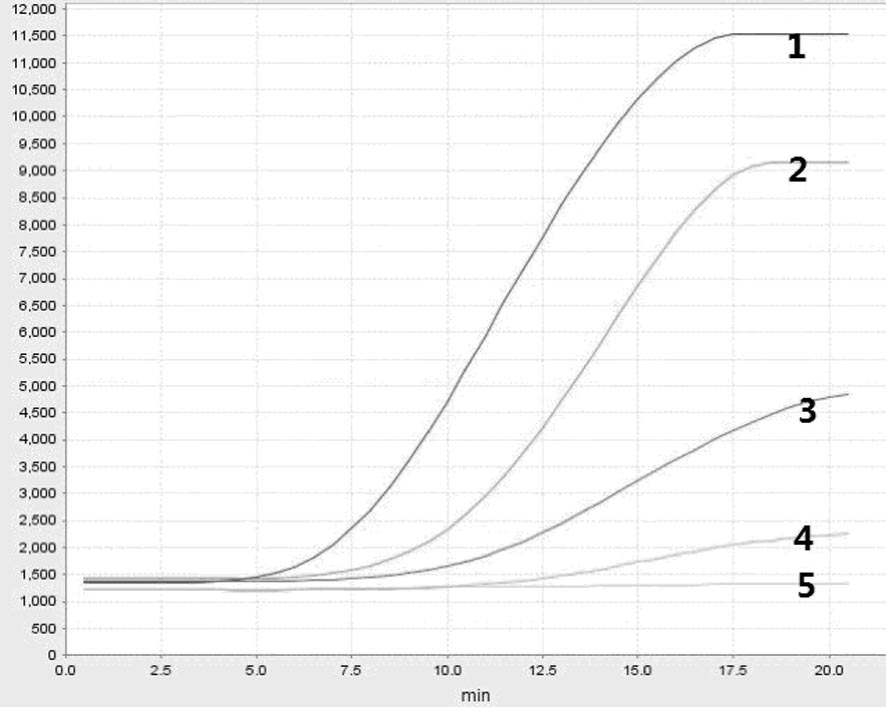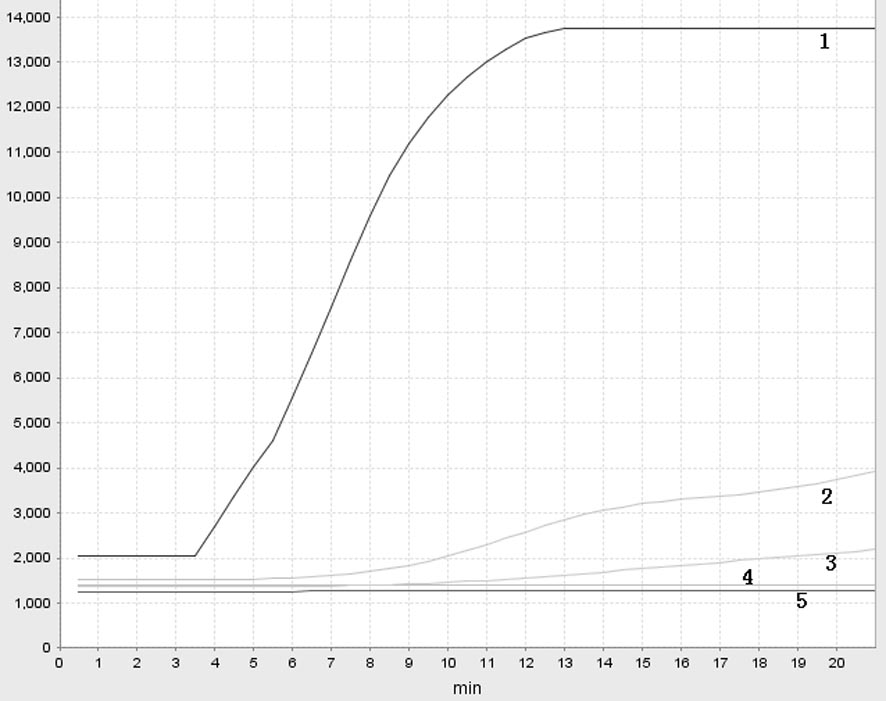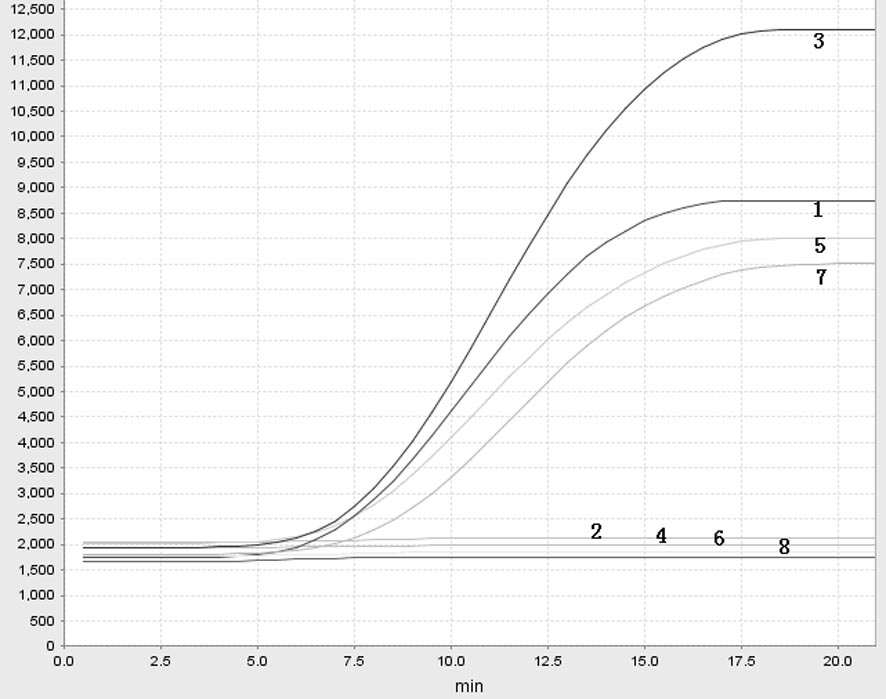Specific primer pair, probe and kit for detecting novel coronavirus
A detection kit and coronavirus technology, applied in the field of probes, detection kits, and specific primer pairs, can solve the problems of complicated machine setup and operation, high price, and high equipment maintenance costs.
- Summary
- Abstract
- Description
- Claims
- Application Information
AI Technical Summary
Problems solved by technology
Method used
Image
Examples
Embodiment 1
[0062] The synthetic plasmid containing the S gene sequence of the new coronavirus is used as the detection target.
[0063] The upstream primer sequence is: 5'-CTCGGCTTTAGAACCATTGGTAGATTTGCCA-3' (Seq ID NO: 1);
[0064] The downstream primer sequence is: 5'- GTGCACAGTCTACAGCATCTGTAATGGTTC-3' (Seq ID NO: 2);
[0065] Probe: 5'-CTTGCTTTACATAGAAGTTATTTGACTCC(FAM-dT)(THF)G(BHQ1-dT)GATTCTTTCTTCAGG-3'(C3-SPACER);
[0066] The nucleic acid sequence of the probe is CTTGCTTTACATAGAAGTTATTTGACTCCTGGTGATTCTTCTTCAGGT (SEQ ID NO: 9).
[0067] Use the recombinant enzyme polymerase amplification (combined with exonuclease III) method to amplify the reaction system for amplification, and construct a 25 μl amplification reaction system as follows:
[0068] 30mM Tris-Acetate Buffer pH8.0
[0069] 100mM potassium acetate
[0070] 14mM magnesium acetate
[0071] 3mM Dithiothreitol
[0072] 5% polyethylene glycol (molecular weight 20000)
[0073] 2mM ATP
Embodiment 2
[0091] Taking the synthesized plasmid containing the S gene sequence of the new coronavirus as the detection target, select the following primer and probe sequences:
[0092] The upstream primer sequence is: 5'-TGCCAATAGGTATTAACATCACTAGGTTT-3' (SEQ ID NO: 3);
[0093] The downstream primer sequence is: 5'-TCTGAGAGAGGGTCAAGTGCACAGTCTAC-3' (SEQ ID NO: 4);
[0094] Probe: 5'-CTTGCTTTACATAGAAGTTATTTGACTCC (FAM-dT)(THF)G(BHQ1-dT)GATTTCTTCTTCAGG-3'(C3-SPACER).
[0095] By synthesizing a plasmid containing the S gene sequence of the new coronavirus as the detection target, carry out the method version amplification test of recombinase polymerase amplification (combined with endonuclease III), and construct a 50 μl amplification reaction system as follows:
[0096] 60mM tris-acetate buffer pH8.0
[0097] 100mM potassium acetate
[0098] 14mM magnesium acetate
[0099] 3mM Dithiothreitol
[0100] 5% polyethylene glycol (20000)
[0101] 2mM ATP
[0102] 20mM creatine phosphate
...
Embodiment 3
[0118] Select the primer pair and probe sequence designed in Example 2, and use the recombinase polymerase amplification (combined with endonuclease IV) method to amplify the reaction system for amplification, and construct a 50 μl amplification reaction system as follows:
[0119] 60mM tris-acetate buffer pH8.0
[0120] 100mM potassium acetate
[0121] 14mM magnesium acetate
[0122] 3mM Dithiothreitol
[0123] 5% polyethylene glycol (molecular weight 20000)
[0124] 2mM ATP
[0125] 20mM creatine phosphate
[0126] 100ng / μl creatine kinase
[0127] 400ng / μl E. coli recA protein
[0128] 200ng / μl E. coli SSB protein
[0129] 60ng / μl E. coli recO protein
[0130] 40ng / μl E. coli recR protein
[0131] 60ng / μl E. coli recF protein
[0132] 8Units Bacillus subtilis DNA polymerase I
[0133] 50ng / μl Endonuclease IV
[0134] 200U reverse transcriptase
[0135] 450 μM dNTPs
[0136] 420nM per upstream primer
[0137] 420nM each downstream primer
[0138] 120nM fluore...
PUM
| Property | Measurement | Unit |
|---|---|---|
| Sensitivity | aaaaa | aaaaa |
Abstract
Description
Claims
Application Information
 Login to View More
Login to View More - R&D Engineer
- R&D Manager
- IP Professional
- Industry Leading Data Capabilities
- Powerful AI technology
- Patent DNA Extraction
Browse by: Latest US Patents, China's latest patents, Technical Efficacy Thesaurus, Application Domain, Technology Topic, Popular Technical Reports.
© 2024 PatSnap. All rights reserved.Legal|Privacy policy|Modern Slavery Act Transparency Statement|Sitemap|About US| Contact US: help@patsnap.com










